Physical and Antimicrobial Properties of Starch-PVA Blend Films as Affected by the Incorporation of Natural Antimicrobial Agents
Abstract
:1. Introduction
2. Materials and Methods
2.1. Materials
2.2. Preparation of Film Forming Dispersion and Films
2.3. Physical Properties of Films
2.3.1. Film Thickness
2.3.2. Moisture Content
2.3.3. Water Vapour Permeability
2.3.4. Internal Transmittance
2.3.5. Gloss
2.3.6. Mechanical Properties
2.4. Microbiological Analysis
2.4.1. Screening Test of the Antifungal Natural Substances
2.4.2. Antimicrobial Effectiveness of the Films
2.5. Statistical Analysis
3. Results and Discussion
3.1. Screening Test: Selection of Antimicrobials
| E | Concentration (v/v) | A. niger Log(UFC/mL) | P. expansum Log(UFC/mL) |
|---|---|---|---|
| Control | - | 4.36 ± 0.10 a | 4.56 ± 0.09 a,b |
| Echinacea extract | 1% | 4.35 ± 0.16 a | 4.7 ± 0.4 b |
| 10% | 4.44 ± 0.12 a | 4.60 ± 0.10 a,b | |
| Horsetail extract | 1% | 4.64 ± 0.07 b | 4.64 ± 0.02 a,b |
| 10% | 4.72 ± 0.02 b | 4.9 ± 0.2 c | |
| Liquid smoke | 1% | 4.53 ± 0.05 a,b | 4.56 ± 0.02 a |
| 10% | 5.04 ± 0.22 c | 5.252 ± 0.002 d | |
| Neem oil | 1% | 4.35 ± 0.10 a | 4.34 ± 0.06 e |
| 10% | 0 d | 0 f |
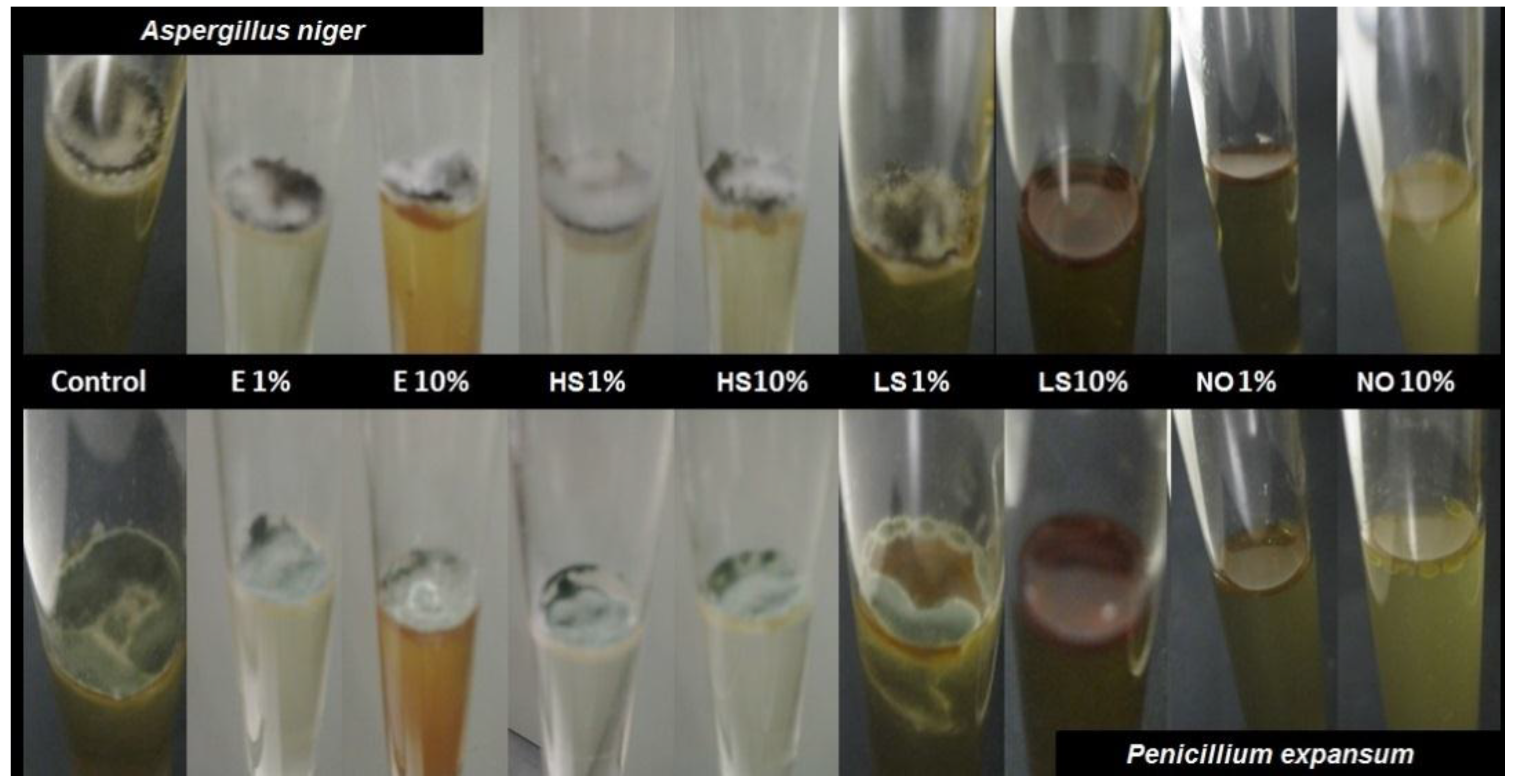
3.2. Physical Characterization of Bioactive Films
| FILMS | MC (%) | WVP (gmm/sm2kPa) | Ti—λ = 450 nm (%) | Gloss (60°) | ||||
|---|---|---|---|---|---|---|---|---|
| 1W | 5W | 1W | 5W | 1W | 5W | 1W | 5W | |
| S-PVA | 6.3 ± 0.5 a,1 | 7.9 ± 0.3 a,2 | 4.39 ± 0.14 a,b,1 | 5.1 ± 0.8 a,1 | 86.2 ± 0.6 a,1 | 85.9 ± 0.6 a,1 | 13.2 ± 1.6 a,b,1 | 12.9 ± 1.2 a,1 |
| S-PVA-1OEO | 4.4 ± 0.2 b,1 | 8.3 ± 0.2 b,2 | 4.6 ± 0.6 b,c,1 | 5.2 ± 0.5 a,1 | 84.5 ± 0.7 c,1 | 84.5 ± 0.7 c,1 | 14.2 ± 1.6 a,1 | 13.5 ± 0.3 a,1 |
| S-PVA-2OEO | 4.33 ± 0.13 b,1 | 7.66 ± 0.11 a,2 | 4.9 ± 0.5 c,1 | 4.7 ± 0.3 a,b,1 | 81.6 ± 0.2 b,1 | 79.5 ± 0.2 b,1 | 12.3 ± 1.2 b,1 | 10.7 ± 0.8 b,1 |
| S-PVA-1NO | 4.5 ± 0.3 b,1 | 7.0 ± 0.3 c,2 | 3.7 ± 0.3 a,1 | 3.6 ± 0.8 b,c,1 | 79.5 ± 0.8 e,1 | 77.9 ± 0.6 e,1 | 12 ± 3 b,1 | 11 ± 3 b,1 |
| S-PVA-2NO | 6.70 ± 0.13 a,1 | 6.69 ± 0.14 d,1 | 4.1 ± 0.4 a,b,1 | 3.9 ± 0.8 c,1 | 74.3 ± 0.8 d,1 | 71.2 ± 1.4 d,1 | 8.5 ± 0.9 c,1 | 7. 9 ± 0.3 c,1 |
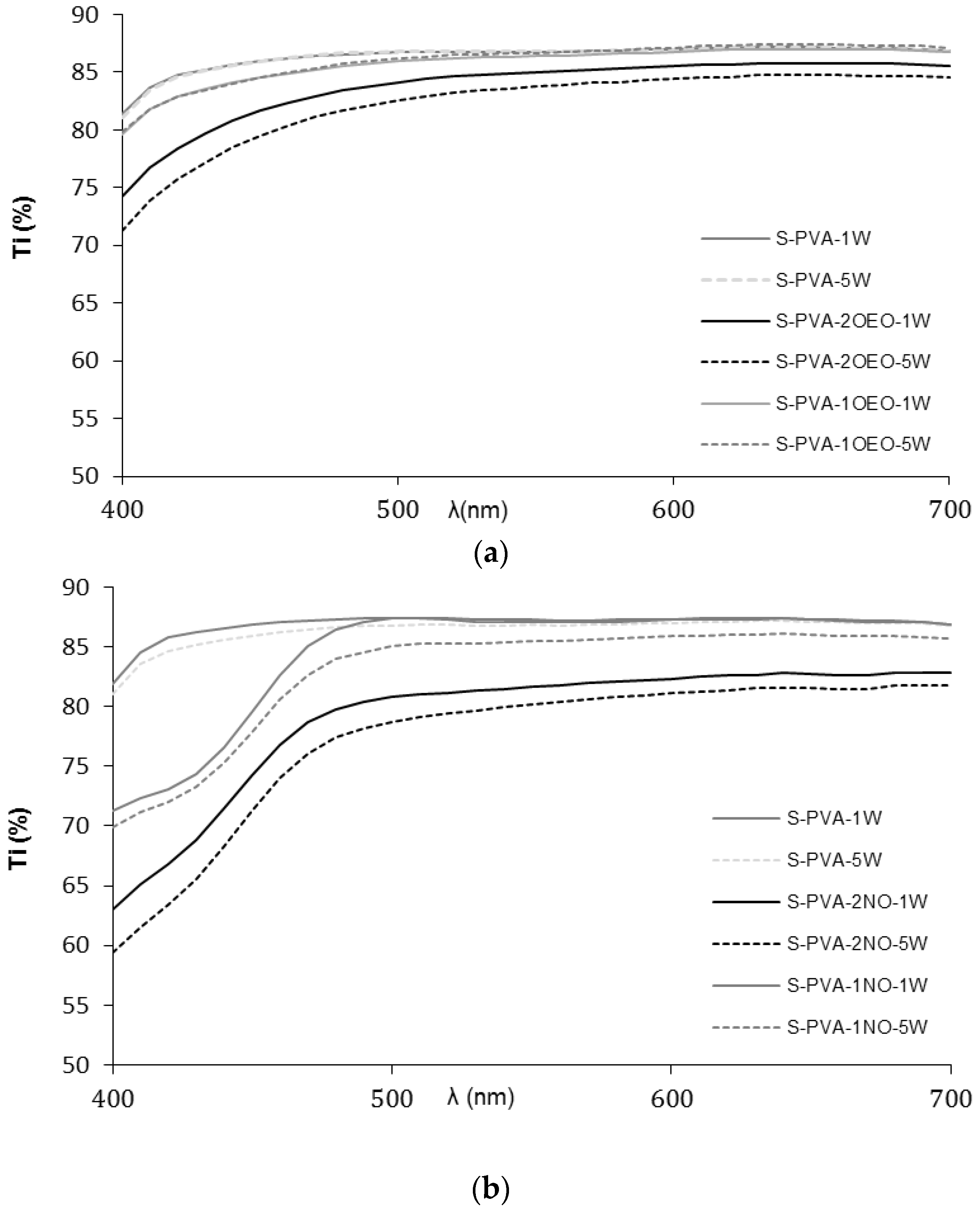
| FILMS | EM (MPa) | TS (MPa) | E (%) | |||
|---|---|---|---|---|---|---|
| 1W | 5W | 1W | 5W | 1W | 5W | |
| S-PVA | 506 ± 63 a,1 | 690 ± 44 a,2 | 26.8 ± 1.4 a,1 | 32.3 ± 1.6 a,2 | 40 ± 4 a,1 | 41 ± 3 a,1 |
| S-PVA-1OEO | 502 ± 50 a,1 | 329 ± 53 b,c,2 | 26 ± 2 a,1 | 20.6 ± 1.5 b,2 | 42 ± 11 a,1 | 61 ± 9 b,2 |
| S-PVA-2OEO | 271 ± 49 b,1 | 355 ± 37 b,1 | 4.33 ± 0.13 b,1 | 7.66 ± 0.11 c,1 | 4.9 ± 0.5 b,1 | 4.7 ± 0.3 c,1 |
| S-PVA-1NO | 413 ± 32 c,1 | 296 ± 11 c,2 | 21.5 ± 1.0 c,1 | 19 ± 2 d,1 | 44 ± 7 a,1 | 60 ± 17 b,2 |
| S-PVA-2NO | 174 ± 14 d,1 | 124 ± 20 d,1 | 7.2 ± 0.6 d,1 | 6.8 ± 0.7 e,1 | 11 ± 2 b,1 | 21 ± 6 d,2 |
3.3. Antibacterial Activity of Composite Films

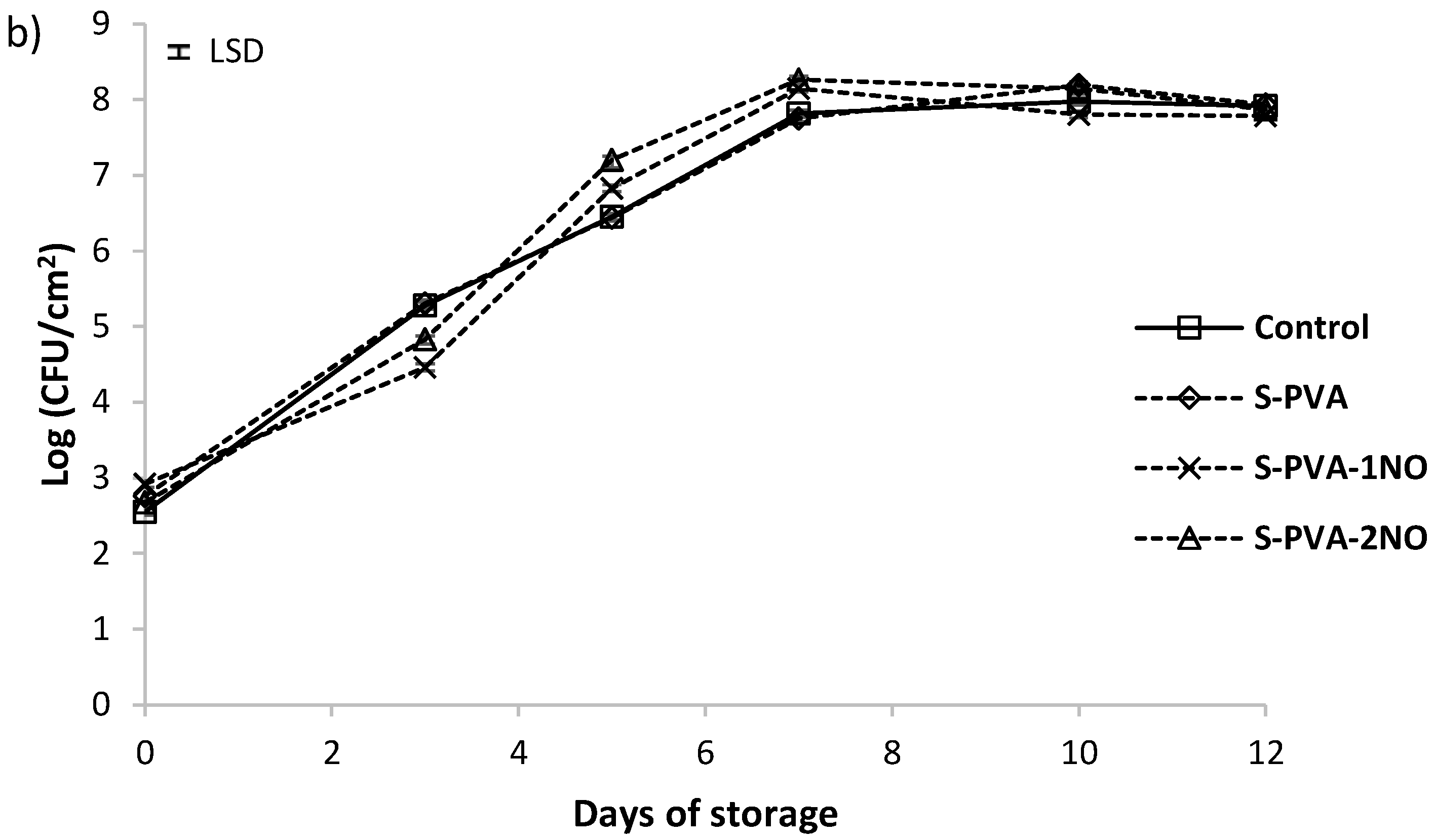
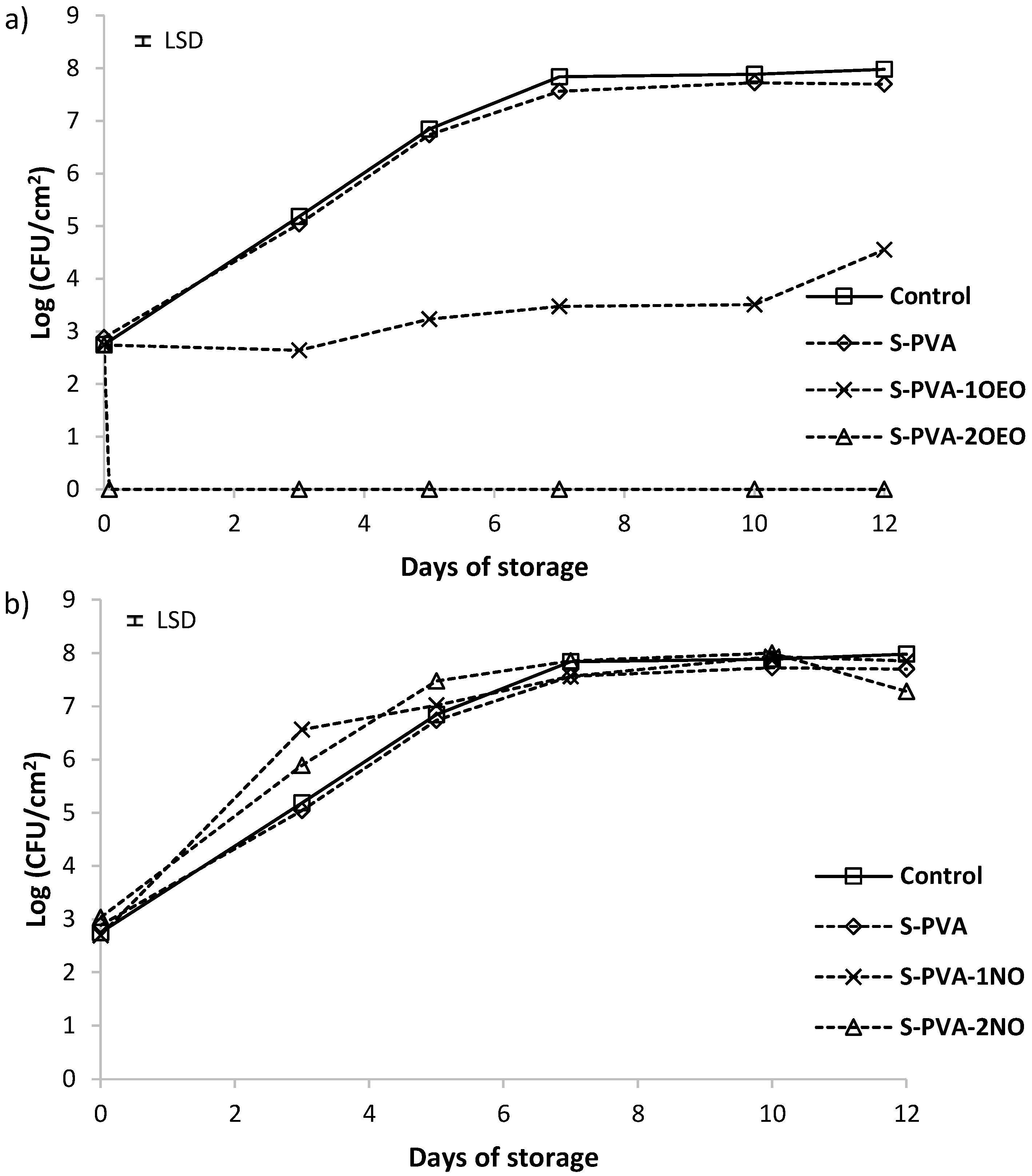
3.4. Antifungal Activity of Composite Films

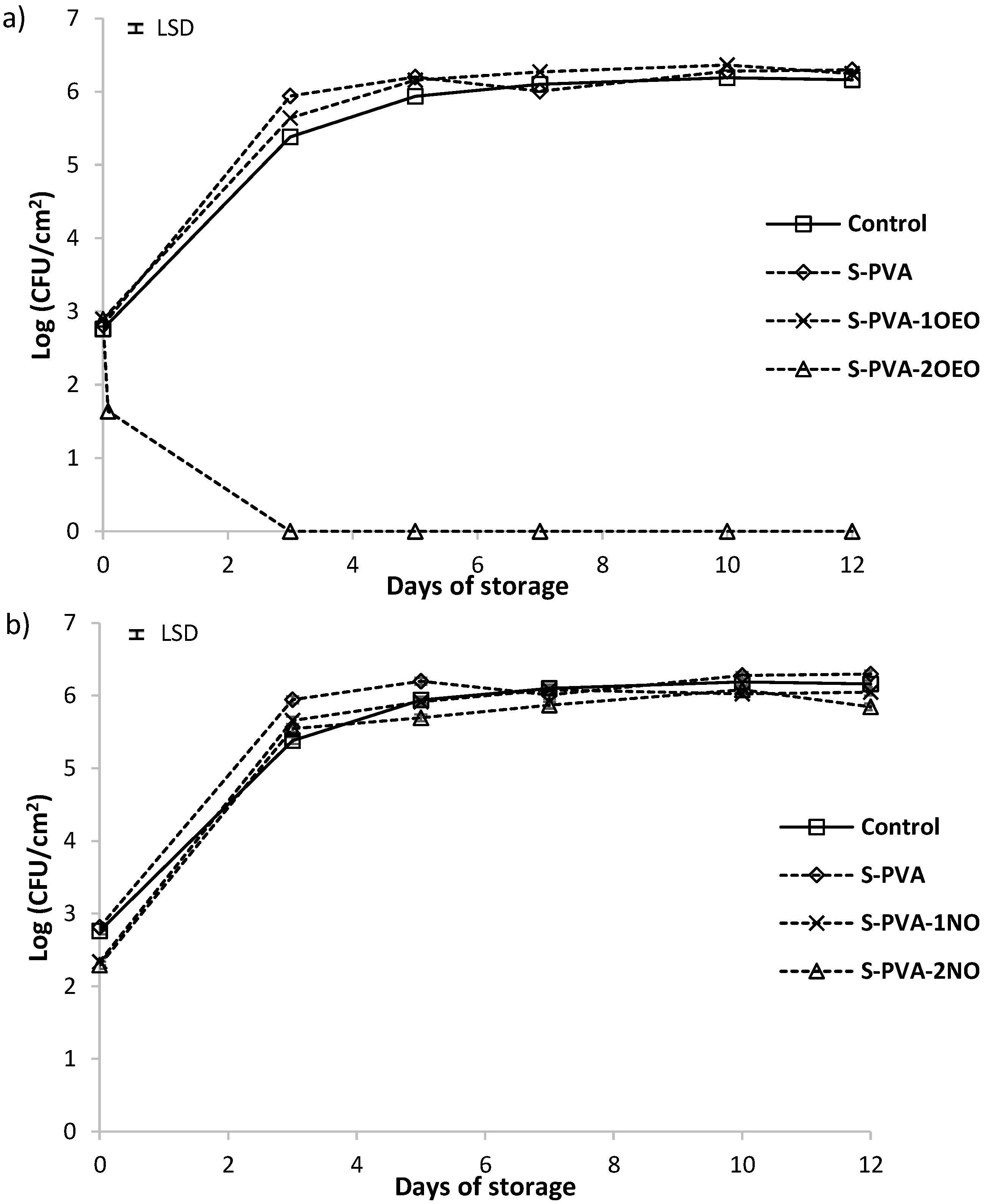
4. Conclusions
Acknowledgments
Author Contributions
Conflicts of Interest
References
- Farjana, A.; Zerin, N.; Kabir, M.S. Antimicrobial activity of medicinal plant leaf extracts against pathogenic bacteria. Asian Pac. J. Trop. Dis. 2014, 4, S920–S923. [Google Scholar] [CrossRef]
- Shihabudeen, M.H.; Priscilla, D.H.; Thirumurugan, K. Antimicrobial activity and phytochemical analysis of selected Indian folk medicinal plants. Int. J. Pharm. Sci. Res. 2010, 1, 430–434. [Google Scholar]
- Utama, I.M.S.; Willis, R.B.H.; Ben-Yehoshua, S.; Kuek, C. In vitro efficacy of plant volatiles for inhibiting the growth of fruit and vegetable decay microorganisms. J. Agric. Food Chem. 2002, 50, 6371–6377. [Google Scholar] [CrossRef] [PubMed]
- Barret, B. Medicinal properties of Echinacea: A critical review. Phytomedicine 2003, 10, 66–86. [Google Scholar] [CrossRef] [PubMed]
- Stanisavljević, I.; Stojičević, S.; Veličković, V.; Lazić, M. Antioxidant and Antimicrobial Activities of Echinacea (Echinacea purpurea L.) Extracts Obtained by Classical and Ultrasound Extraction. Chin. J. Chem. Eng. 2009, 17, 478–483. [Google Scholar] [CrossRef]
- Mahoney, N.; Molyneux, R.J. Phytochemical inhibition of aflatoxigenicity in Aspergillus flavus by constituents of walnut (Juglans regia). J. Agric. Food Chem. 2004, 52, 1882–1889. [Google Scholar] [CrossRef] [PubMed]
- Radulovic, N.; Stojanovic, G.; Palic, R. Composition and antimicrobial activity of Equisetum arvense L. essential oil. Phytother. Res. 2006, 20, 85–88. [Google Scholar] [CrossRef] [PubMed]
- Samapundo, S.; de Meulenaer, B.; Osei-Nimoh, D.; Lamboni, Y.; Debevere, J.; Devlieghere, F. Can phenolic compounds be used for the protection of corn from fungal invasion and mycotoxin contamination during storage? Food Microbiol. 2007, 24, 465–473. [Google Scholar] [CrossRef] [PubMed]
- García, D.; Ramos, A.J.; Sanchis, V.; Marín, S. Effect of Equisetum arvense and Stevia rebaudiana extracts on growth and mycotoxin production by Aspergillus flavus and Fusarium verticillioides in maize seeds as affected by water activity. Int. J. Food Microbiol. 2012, 153, 21–27. [Google Scholar] [CrossRef] [PubMed]
- Sanuja, S.; Agalya, A.; Umapathy, M.J. Synthesis and characterization of zinc oxide-neem oil-chitosan bionanocomposite for food packaging application. Int. J. Biol. Macromol. 2015, 74, 76–84. [Google Scholar] [CrossRef] [PubMed]
- Pu, Z.-H.; Zhang, Y.-Q.; Yin, Z.-Q.; Xu, J.; Jia, R.-Y.; Lu, Y.; Yang, F. Antibacterial Activity of 9-Octadecanoic Acid-Hexadecanoic Acid- Tetrahydrofuran-3,4-Diyl Ester from Neem Oil. Agric. Sci. China 2010, 9, 1236–1240. [Google Scholar] [CrossRef]
- Xu, J.; Du, Y.H.; Yin, Z.Q.; Li, X.T.; Jia, R.Y.; Wang, K.Y.; Lv, C.; Fan, Q.J.; Ye, G.; Geng, Y.; et al. The preparation of neem oil microemulsion (Azadirachta indica) and the comparison of acaricidal time between neem oil microemulsion and other formulations in vitro. Vet. Parasitol. 2010, 164, 399–403. [Google Scholar] [CrossRef] [PubMed]
- Baswa, M.; Rath, C.C.; Dash, S.K.; Mishra, R.K. Antibacterial activity of Karanj (Pongamia pinnata) and Neem (Azadirachta indica) seed oil: A preliminary report. Microbiology 2001, 105, 183–189. [Google Scholar]
- Rao, D.V.K.; Singh, I.; Chopra, P. In vitro antibacterial activity of neem oil. Indian J. Med. Res. 1986, 6, 314–316. [Google Scholar]
- Patel, R.P.; Trivedi, B.M. The in vitro antibacterial activity of some medicinal oils. Indian J. Med. Res. 1962, 8, 218–222. [Google Scholar]
- Vanka, A.; Tandon, S.; Rao, S.R.; Udupa, N.; Ramkumar, P. The effect of indigenous Neem (Adirachtaindica) mouth wash on Streptococcus mutans and lactobacilli growth. Indian J. Dent. Res. 2001, 12, 133–144. [Google Scholar] [PubMed]
- Mahfuzul Hoque, M.D.; Bari, M.L.; Inatsu, Y.; Juneja, V.K.; Kawamoto, S. Antimbacterial activity of Guava (Psidium guajava L.) and Neem (Azadirachta indica A. Juss.). Extracts against foodborne pathogens and spoilage bacteria. Foodborne Pathogen. Dis. 2007, 4, 481–488. [Google Scholar] [CrossRef] [PubMed]
- Sánchez-González, L.; González-Martínez, C.; Chiralt, A.; Cháfer, M. Use of Essential Oils in Bioactive Edible Coatings. Food Eng. Rev. 2011, 3, 1–16. [Google Scholar] [CrossRef]
- Aguirre, A.; Borneo, R.; León, A.E. Antimicrobial, mechanical and barrier properties of triticale protein films incorporated with oregano essential oil. Food Biosci. 2013, 1, 2–9. [Google Scholar] [CrossRef]
- Emiroğlu, Z.K.; Yemiş, G.P.; Coşkun, B.K.; Candoğan, K. Antimicrobial activity of soy edible films incorporated with thyme and oregano essential oils on fresh ground beef patties. Meat Sci. 2010, 86, 283–288. [Google Scholar] [CrossRef] [PubMed]
- Zivanovic, S.; Chi, S.; Draughon, A.F. Antimicrobial activity of Chitosan films enriched with essential oils. J. Food Sci. 2005, 70, M45–M51. [Google Scholar] [CrossRef]
- Burt, S. Essential oils: Their antimicrobial properties and potential applications in foods-a review. Int. J. Food Microbiol. 2004, 94, 223–253. [Google Scholar] [CrossRef] [PubMed]
- Jouki, M.; Yazdi, F.T.; Mortazavi, S.A.; Koocheki, A. Quince seed mucilage films incorporated with oregano essential oil: Physical, thermal, barrier, antioxidant and antibacterial properties. Food Hydrocoll. 2014, 36, 9–19. [Google Scholar] [CrossRef]
- Sadaka, F.; Nguimjeu, C.; Brachais, C.-H.; Vroman, I.; Tighzert, L.; Couvercelle, J.-P. Review on antimicrobial packaging containing essential oils and their active biomolecules. Innov. Food Sci. Emerg. Technol. 2014. [Google Scholar] [CrossRef]
- Corrales, M.; Fernández, A.; Han, J.H. Chapter 7: Antimicrobial packaging systems. In Innovations in Food Packaging, 2nd ed.; Han, J.H., Ed.; Academia Press: San Diego, CA, USA, 2014; pp. 133–170. [Google Scholar]
- Martucci, J.F.; Gende, L.B.; Neira, L.M.; Ruseckaite, R.A. Oregano and lavender essential oils as antioxidant and antimicrobial additives of biogenic gelatin films. Ind. Crops Prod. 2015, 71, 205–213. [Google Scholar] [CrossRef]
- Lingbeck, J.M.; Cordero, P.; O’Bryan, C.A.; Johnson, M.G.; Ricke, S.C.; Crandall, P.G. Functionality of liquid smoke as an all-natural antimicrobial in food preservation. Meat Sci. 2014, 97, 197–206. [Google Scholar] [CrossRef] [PubMed]
- Saloko, S.; Darmadji, P.; Setiajic, B.; Pranoto, Y. Antioxidative and antimicrobial activities of liquid smoke nanocapsules using chitosan and maltodextrin and its application on tuna fish preservation. Food Biosci. 2014, 7, 71–79. [Google Scholar] [CrossRef]
- Cho, S.Y.; Lee, D.S.; Han, J.H. Antimicrobial packaging. In Encyclopedia of Packaging Technology; Yam, K., Ed.; Wiley Blackwell Publishing: Ames, IA, USA, 2009; pp. 50–58. [Google Scholar]
- Rodrigues, E.T.; Han, J.H. Antimicrobial whey protein films against spoilage and pathogenic bacteria. In IFT Annual Meeting: Book of Abstracts; Institute of Food Technologists: Chicago, IL, USA, 2000; p. 191. [Google Scholar]
- Rodrigues, E.T.; Han, J.H.; Holley, R.A. Optimized antimicrobial edible whey protein films against spoilage and pathogenic bacteria. In IFT Annual Meeting: Book of Abstracts; Institute of Food Technologists: Chicago, IL, USA, 2002; p. 252. [Google Scholar]
- Lanciotti, R.; Gianotti, A.; Patrignani, F.; Belletti, N.; Guerzoni, M.E.; Gardini, F. Use of natural aroma compounds to improve shelflife and safety of minimally processed fruits. Trends Food Sci. Technol. 2004, 15, 201–208. [Google Scholar] [CrossRef]
- Cano, A.I.; Cháfer, M.; Chiralt, A.; González-Martínez, C. Physical and microstructural properties of biodegradable films based on pea starch and PVA. J. Food Eng. 2015, 167. [Google Scholar] [CrossRef]
- Sánchez-González, L.; González-Martínez, C.; Chiralt, A.; Cháfer, M. Physical and antimicrobial properties of chitosan-tea tree essential oil composite films. J. Food Eng. 2010, 98, 443–452. [Google Scholar] [CrossRef]
- American Society for Testing and Materials. Standard test methods for specular gloss. Designation (D523). In Annual Book of ASTM Standards; ASTM: Philadelphia, PA, USA, 1999; Volume 06.01. [Google Scholar]
- Hutchings, J.B. Food and Colour Appearance (Chapman and Hall Food Science Book), 2nd ed.; Aspen Publication: Gaithersburg, MD, USA, 1999. [Google Scholar]
- American Society for Testing and Materials. Standard test methods for water vapour transmission of materials. In Standard Designations: E96–95 Annual Book of ASTM Standards; ASTM: Philadelphia, PA, USA, 1995; pp. 406–413. [Google Scholar]
- American Society for Testing and Materials. Standard test method for tensile properties of thin plastic sheeting. In Standard D882 Annual Book of American Standard Testing Methods; ASTM: Philadelphia, PA, USA, 2001; pp. 162–170. [Google Scholar]
- Kristo, E.; Koutsoumanis, K.P.; Biliaderis, C.G. Thermal, mechanical and water vapor barrier properties of sodium caseinate films containing antimicrobials and their inhibitory action on Listeria monocytogenes. J. Food Hydrocoll. 2008, 22, 373–386. [Google Scholar] [CrossRef]
- Upadhyay, R.K.; Dwivedi, P.; Ahmad, S. Screening of antibacterial activity of six plant essential oils against pathogenic bacterial strains. Asian J. Med. Sci. 2010, 2, 152–158. [Google Scholar]
- Jahan, T.; Begum, Z.A.; Sultana, S. Effect of neem oil on some pathogenic bacteria. Bangladesh J. Pharmacol. 2007, 2, 71–72. [Google Scholar] [CrossRef]
- Pavlath, A.E.; Orts, W. Edible films and coatings: Why, What and How? In Edible Films and Coatings for Food Applications; Embuscado, M.E., Huber, K.C., Eds.; Springer: Berlin, Germany, 2009; pp. 1–23. [Google Scholar]
- Park, S.; Zhao, Y. Incorporation of a high concentration of mineral or vitamin into chitosan-based films. J. Agric. Food Chem. 2004, 52, 1933–1939. [Google Scholar] [CrossRef] [PubMed]
- Han, J.H.; Krochta, J.M. Wetting properties and water vapor permeability of whey-protein-coated paper. Trans. ASAE 1999, 42, 1375–1382. [Google Scholar] [CrossRef]
- Benavides, S.; Villalobos-Carvajal, R.; Reyes, J.E. Physical, mechanical and antibacterial properties of alginate films: Effect of the crosslinking degree and oregano essential oil concentration. J. Food Eng. 2012, 110, 232–239. [Google Scholar] [CrossRef]
- Villalobos, R.; Chanona, J.; Hernández, P.; Gutiérrez, G.; Chiralt, A. Gloss and transparency of hydroxypropyl methylcellulose films containing surfactants as affected by their microstructure. Food Hydrocoll. 2005, 19, 53–61. [Google Scholar] [CrossRef]
- Fabra, M.J.; Talens, P.; Chiralt, A. Microstructure and optical properties of sodium caseinate films containing oleic acid—Beeswax mixtures. Food Hydrocoll. 2009, 23, 676–683. [Google Scholar] [CrossRef]
- Wu, J.; Ge, S.; Liu, H.; Wang, S.; Chen, S.; Wang, J.; Li, J.; Zhang, Q. Properties and antimicrobial activity of silver carp (Hypophthalmichthys molitrix) skin gelatin-chitosan films incorporated with oregano essential oil for fish preservation. Food Packag. Shelf life 2014, 2, 7–16. [Google Scholar] [CrossRef]
- Hosseini, S.F.; Rezaei, M.; Zandi, M.; Farahmandghavi, F. Bio-based composite edible films containing Origanum vulgare L. essential oil. Ind. Crops Prod. 2015, 67, 403–413. [Google Scholar] [CrossRef]
- Ward, G.; Nussinovitch, A. Gloss properties and surface morphology relationships of fruits. J. Food Sci. 1996, 61, 973–977. [Google Scholar] [CrossRef]
- Fabra, M.J.; Talens, P.; Chiralt, A. Water sorption isotherms and phase transitions of sodium caseinate-lipid films as affected by lipid interactions. Food Hydrocoll. 2010, 24, 384–391. [Google Scholar] [CrossRef]
- Valencia, A.; Rivera, C.; Murillo, E.A. Studio de las propiedades de mezclas de alcohol polivinílico-almidón de yuca-sorbitol obtenidas por casting. Rev. Colomb. Mater. 2013, 4, 41–55. [Google Scholar]
- Chaléat, C.M.; Halley, P.J.H.; Trussb, R.W. Study on the phase separation of plasticised starch/poly(vinylalcohol) blends. Polym. Degrad. Stabil. 2012, 97, 1930–1939. [Google Scholar] [CrossRef]
- Sreekumar, P.A.; Al-Harthi, M.A.; De, S.K. Studies on compatibility of biodegradable starch/polyvinyl alcohol blends. Polym. Eng. Sci. 2012, 52, 2167–2172. [Google Scholar] [CrossRef]
- Muriel-Galet, V.; Cran, M.J.; Bigger, S.W.; Hernández-Muñoz, P.; Gavara, R. Antioxidant and antimicrobial properties of ethylene vinyl alcohol copolymer films based on the release of oregano essential oil and green tea extract components. J. Food Eng. 2015, 149, 9–16. [Google Scholar] [CrossRef]
- Helander, I.M.; Alakomi, H.-L.; Latva-Kala, K.; Mattila-Sandholm, T.; Pol, I.; Smid, E.J.; orris, L.G.M.; von Wright, A. Characterization of the action of selected essential oil components on Gram-negative bacteria. J. Agric. Food Chem. 1998, 46, 3590–3595. [Google Scholar] [CrossRef]
- Lambert, R.J.W.; Skandamis, P.N.; Coote, P.J.; Nychas, G.-J.E. A study of the minimum inhibitory concentration and mode of action of oregano essential oil, thymol and carvacrol. J. Appl. Microbiol. 2001, 91, 453–462. [Google Scholar] [CrossRef] [PubMed]
- Vijatan, V.; Aafreen, S.; Sakthivel, S.; Ravindra Reddy, K. Formulation and characterization of solid lipid nanoparticles loaded Neem oil for topical treatment of acne. J. Acute Disease, 2013, 2, 282–286. [Google Scholar] [CrossRef]
© 2015 by the authors; licensee MDPI, Basel, Switzerland. This article is an open access article distributed under the terms and conditions of the Creative Commons by Attribution (CC-BY) license (http://creativecommons.org/licenses/by/4.0/).
Share and Cite
Cano, A.; Cháfer, M.; Chiralt, A.; González-Martínez, C. Physical and Antimicrobial Properties of Starch-PVA Blend Films as Affected by the Incorporation of Natural Antimicrobial Agents. Foods 2016, 5, 3. https://doi.org/10.3390/foods5010003
Cano A, Cháfer M, Chiralt A, González-Martínez C. Physical and Antimicrobial Properties of Starch-PVA Blend Films as Affected by the Incorporation of Natural Antimicrobial Agents. Foods. 2016; 5(1):3. https://doi.org/10.3390/foods5010003
Chicago/Turabian StyleCano, Amalia, Maite Cháfer, Amparo Chiralt, and Chelo González-Martínez. 2016. "Physical and Antimicrobial Properties of Starch-PVA Blend Films as Affected by the Incorporation of Natural Antimicrobial Agents" Foods 5, no. 1: 3. https://doi.org/10.3390/foods5010003






